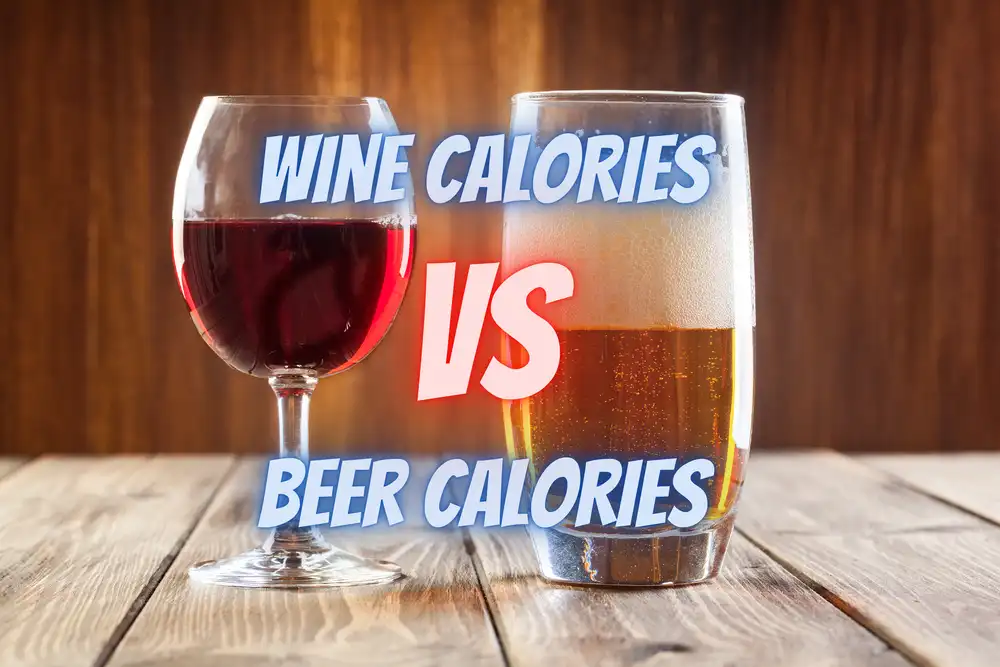There’s nothing quite like a delicious beer or wine to get your blood flowing. But which of these drinks is healthier for you? Ah, there lies the eternal debate.
Though neither drink is obviously a healthy food, their calorie count can be quite different and, if you’re trying to lose weight, one of these drinks is definitely better for you.
But which is it? Let’s take a deeper look at this subject to find out.

Which Has More Calories, Beer or Wine?
Let’s give readers a short-short answer to this debate right away: beer typically has more calories than wine.
Sometimes, many more calories! However, the health debate between beer vs. wine is more complex than it might seem on the surface.
That’s because beer might have slightly more nutrients than wine: at least some wines. Confused? That’s why this article is necessary!
If you’re still on the fence about which is the best for you, take a look at this list below to get an idea of which might be the best for your situation.
It includes comparable wine and beer options and their ABV (alcohol by volume), which should help you make an informed decision when picking (each wine is a six-ounce serving, and beer a 12-ounce serving):
Lightest Calorie Options – 6oz wine serving and 12oz beer serving
- Light White Wine: 8-10% ABV and 95 to 139 calories
- Light Beer: 3-4% ABV and 95 to 139 calories
Light Calorie Options – 6oz wine serving and 12oz beer serving
- Champagne: 12% ABV and 125 to 160 calories
- Lager: 4-5% ABV and 140 to 191 calories
Mid-Calorie Options – 6oz wine serving and 12oz beer serving
- Standard Wine (dry reds and white): 12.5-13.5% ABV and 175 to 187 calories
- ALA/IPA: 5-6.5% ABV and 163 to 228 calories
High Calorie Options – 6oz wine serving and 12oz beer serving
- High ABV Wine: 13.5-16% ABV and 187 to 219 calories
- Belgium Beer: 6.5-9.5% ABV and 201 to 303 calories
Highest Calorie Options – 6oz wine serving and 12oz beer serving
- Dessert Wines: 16-20% ABV and 220 to 260 calories
- Imperial IPA: 9-12% ABV and 260 to 360 calories
Calories in Wine
Like beer, wine comes in many varieties, and it isn’t always easy to nail down how many calories you get in a glass of wine.
A standard 175-milliliter wine glass (just over six ounces) of a 12% alcohol-by-volume wine has about 133 calories or so. Note: the calories typically go down as alcohol content goes up because the wine will be drier and contain less sugar.
However, it is also important to remember that wine calories will vary based on the type you drink.
The variations here may not be huge but should be noted for simplicity.
For example, red wine tends to have a higher calorie count: between 75-85 calories per 100 milliliters or 3.5-ounce glass.
The same serving of white wine gives you about 73-83 calories, while a similar rosé serving is about 70-80 calories.
If you would like to stick with lower calories, dry whites like Riesling and Pinot Grigio are low in calorie count.
Drinking Glass Calories
What about if you’re more of a heavy drinker of wine?
While some people enjoy five-ounce glasses of wine, others may drink at least eight ounces or 227 milliliters of wine at one time.
Calories here go up heavily: red wines would be 154 to 175 calories per eight-ounce glass.
By comparison, white wine would be between 150 to 171 calories and rosé 144 to 165 calories in the same serving glass.
What if you upgrade to a 22-ounce glass, a common big-volume wine glass? Naturally, your calories increase heavily: almost by 300 percent.
They’d include: red wines, 423 to 481 calories, white wines 412 to 470, and rosé wines at 396 to 453 calories per bottle.
Related: Sugar content in wine glass and bottle.
Wine Health Benefits
Multiple studies have confirmed that a glass of wine per day (red wine tends to be more healthy) helps to decrease your risk of cardiovascular diseases, such as heart attacks, and may even help with cancer.
Wine helps dilate arteries and increases blood flow, and can even minimize cholesterol-related heart damage. Not bad!
Related: Drinking wine on a keto diet.
Calories in Beer
Like wine, beer comes in many varieties, but a pint of beer has around 240 calories.
For reference, that’s about 16 ounces, meaning you get around 120 average calories per eight ounces.
That seems to indicate that beer has fewer calories than wine, but other factors are at play here. For example, dark beers can have up to 300 calories per the same serving size due to heavy carbohydrates.
Lighter beers typically have between 60 and 120 calories for the same pint drink size, as they have far fewer carbohydrates.
It is important to remember, though, that wine and beer consumption patterns are quite different. Many wine fans are content with one five-ounce glass and rarely drink much more than that.
However, beer drinkers may have two or more beers a day or splurge on the weekends and drink far more. Even five pints of beer a week for a whole year (over 54,000 calories) is equivalent to 235 standard size Mars bars.
Calories Also Vary Based On Can and Bottle Size
It is important to note that a typical can or bottle of beer (about 12 ounces) will have more calories than a typical wine serving.
Those 12 ounces have about 180 calories on average and potentially 450 calories per can with darker beers. If you upgrade to 40-ounce cans, you’re talking about even more calories per serving.
A standard 120-calorie per 12-ounce beer would be 400 calories per 40-ounce serving.
And a 300-calorie per 12-ounce dark beer would be 1,000 calories per 40-ounce bottle or can!
These servings are by far some of the most calorie-dense drinks on the market, far exceeding the average wine drinker’s consumption of 8-12 ounces per night.
Beer Does Have More Nutrients
While wine is often touted as a wonder drink, it is important to remember that beer has more nutrients than wine.
It contains far more protein, fiber, B vitamins, folate, and niacin. Of course, that doesn’t mean a beer a day keeps the doctor away, but it is a point worth considering.
Wine vs. Beer Calories: Which One Wins?
When it comes to calorie combat, wine probably slightly edges beer thanks to lower-carbohydrate (drier) wines, smaller serving sizes (usually), and less binge-drinking patterns (typically).
However, it is also important to remember that both can be quite a calorie-dense drink, particularly if you’re enjoying multiple drinks in a night and aren’t careful about your alcohol intake.
As always, moderation is key.
- Shrimp Cocktail (and More) Wine Pairing Guide - 09/06/2022
- What Wine Serving Sizes Look Like: Standard Size and More - 08/06/2022
- How Much Sugar is in Wine: Glass and Bottle Sugar Content - 08/06/2022






